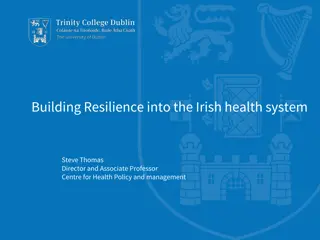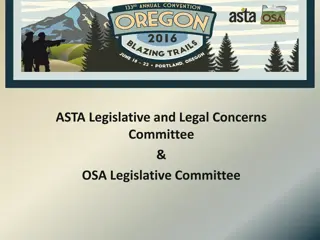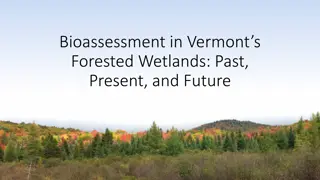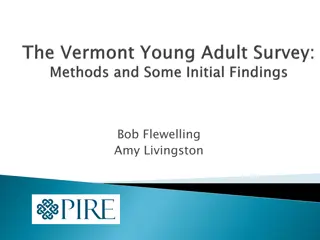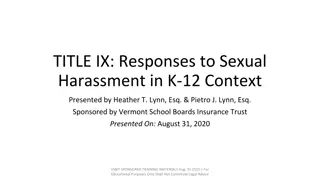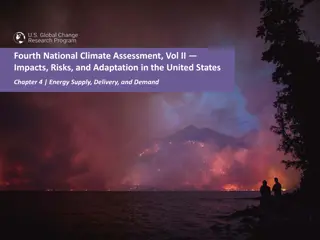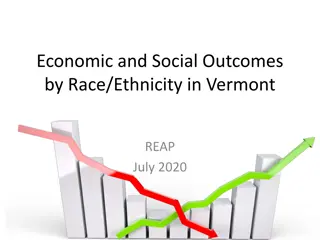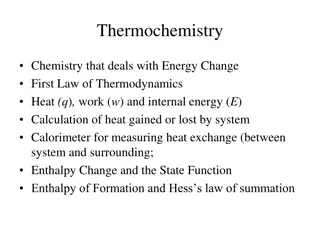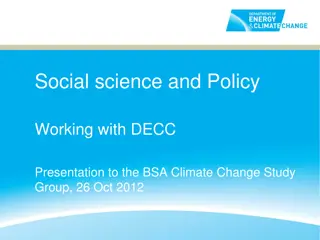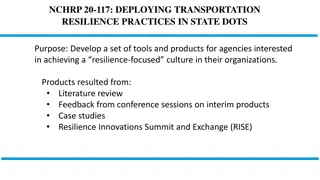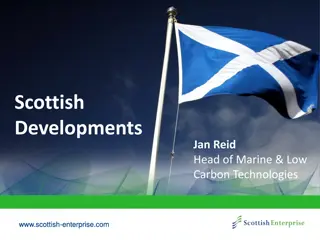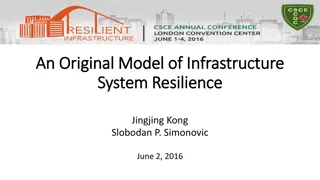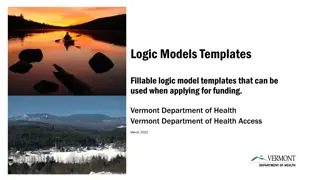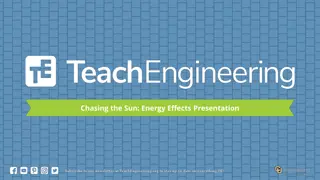Energy System Change for Economic Resilience in Vermont
This text discusses the importance of renewable energy transition in Vermont for economic resilience, focusing on the social, political, and cultural dimensions. It highlights the shift from fossil fuel-based to renewable energy systems and the need for inclusive and distributed energy systems to facilitate social changes. Various perspectives on energy system change, including centralization vs. decentralization and the role of smart grids, are also explored in the context of broader civic engagement. The text underscores the significance of energy transition for both climate mitigation and resilience, as evident from events like Superstorm Sandy and Hurricane Irene.
Download Presentation

Please find below an Image/Link to download the presentation.
The content on the website is provided AS IS for your information and personal use only. It may not be sold, licensed, or shared on other websites without obtaining consent from the author. Download presentation by click this link. If you encounter any issues during the download, it is possible that the publisher has removed the file from their server.
E N D
Presentation Transcript
Energy System Change for Economic Resilience in Vermont November 17, 2015 UVM Legislative Policy Summit Vermont's 21st Century Economy: Building an Entrepreneurial Ecosystem Jennie C. Stephens, Ph.D. Associate Professor Blittersdorf Professor of Sustainability Science and Policy Rubenstein School of Environment and Natural Resources College of Engineering and Mathematical Sciences The Energy-Climate Transitions Research Group
My Research: Social, Political & Cultural Dimensions of the Renewable Energy Transition The Renewable Energy Transition Renewable based energy systems Fossil fuel based energy systems So much more than a technical substitution A shift from fierce competition for a scarce resource (fossil fuels) to system based on abundant, plentiful, perpetual energy Tend to focus on supply but changes in energy demand/consumption also required More inclusive and distributed energy system could facilitate social changes in expectations and assumptions regarding how much energy we use
Diverse Perspectives on Energy System Change & Smart Grid G. Renee Guzlas, artist Centralization vs. decentralization Centralized systems offer scale Decentralized systems more flexible, modular, and adaptive includes more social change Cambridge University Press February 2015 Multiple opportunities for broader civic engagement in energy system change More inclusive Distributed benefits and wealth
Electricity as well as transportation & heat The renewable energy transition includes heat, light, & mobility TRANSPORT ELECTRICITY HEAT earthatnight http://greenacton.org/outdoorlighting.htm In China, Bosker, 2014. The Guardian. August 2014 McMansions, 6 bedrooms, 5.5 baths, almost 7,000 sq. feet -
Energy transition for climate mitigation but also for climate resilience Superstorm Sandy (October 2012) and Hurricane Irene (2011) revealed energy system vulnerabilities Electricity infrastructure damage 8.6 million customers lost power Hoboken, NJ. Charging electronic devices (Jeff Zelevansky/Getty Images) Highlighted increasing reliance on electricity for basic needs: communication, food, etc. Hopewell Township, NJ three days after the storm. The Trentonian, Jackie Schear/AP Photo.
Transitions are necessarily disruptive Resistance from powerful entrenched actors inevitable With disruption comes opportunity for social/cultural change Renewable based energy systems Fossil fuel based energy systems Not a simple technological substitution Social, political, cultural and institutional change too
Fundamental Tension: Centralization vs. Decentralization Decentralized Local Control Community-based energy Microgrids & locavolts Centralized Supergrid with Long Distance Transmission Reinforcing current institutional arrangements/control Desertec Desertec - Eumena 2012 Smart Grid Enterprise 2013
Learning-by-Doing: Leaders in the Renewable Energy Transition Vermont - a leader in the US Germany a leader in the EU Energiewende (energy revolution) 60% renewables by 2050 National commitment to renewables Comprehensive Energy Plan 90% renewables by 2050 Electricity, heating & transportation Town Energy Committees Source: VT Energy and Climate Action Network
Reed, E. (2015). How Vermont became a clean-power powerhouse. Christian Science Monitor. September 12, 2015. http://www.csmonitor.com/Environment/2015/0912/How-Vermont-became-a-clean-power-powerhouse McKibben, B. (2015). "Power to the People: Why the rise of green energy makes utility companies nervous." The New Yorker. http://www.newyorker.com/magazine/2015/06/29/power-to-the-people http://www.burlingtonfreepress.com/story/news/2015/10/15/bill-mckibben- arrested-vermont-gas-pump-protest/73999386/
Distributed Renewable Energy in VT offers Flexibility Modularity Adaptive Community autonomy Energy Independence Self-Sufficiency Economic stability Engagement Photo Source: Georgia Mountain Wind
Diversity in Energy: Multiple societal benefits of greater gender diversity in the energy workforce Mothers Out Front: Mobilizing for a Livable Climate It is time for a swift and complete transition to clean energy Mothers Out Front Massachusetts State House Promote more sustainable energy practices More inclusive engagement in energy system change Accelerate innovation Enhance economic opportunities for women Photo Source: Georgia Mountain Wind
Energy Democracy Framework (Fairchild, 2015) (1) A set of values: includes environmental, climate, and social justice (2) An alternative economic model: shared, distributed wealth, addresses income inequality (3) new legal & governing structures, community-based rather than corporate control (4) incorporates emerging renewable technologies Alternative to current fossil fuel dominated context Fossil Fuel industry .. most profitable industry in the world characterized by income inequality failure to distribute wealth top 5 CEOs make 400X median income public resources supporting this $14 billion in tax breaks and subsidies Concentration of wealth and power Cleantechnica.com Energy democracy movement part of inequality movement, black lives matter movement, human rights movement, etc
Growing Acknowledgement of the Need to Expand Energy Research, Teaching, & Learning Webler, T. and S. P. Tuler (2010). Energy Policy 38: 2690-2691. Sovacool, B. K. (2014). "Energy studies need social science." Nature 511: 529-530 Under-evaluation of social dimensions Under-representation of women and minorities Minimal integration of engineering and social science Minimal collaborative efforts
Acknowledgements The UVM Energy-Climate Transitions Research Team Publications available on website Email: jennie.stephens@uvm.edy Website: blog.uvm.edu/jstephe1 Thank you!




